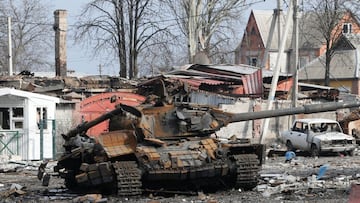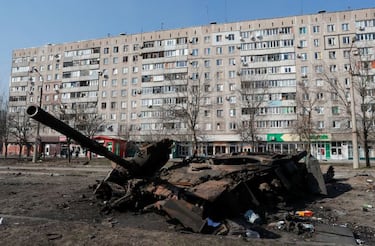Has Russia lost military capacity since the beginning of the invasion?
The invasion is a month old and the Russian army's progress has slowed to a crawl. How well has Ukraine been defending?


The Russian invasion of Ukraine is a month old and the expectation of a war over "within 72 hours," the Russians have yet to conquer Kyiv. Much of the east is under huge bombardment, as well as the siege of Mariupol in the south which has harkened minds back to some of the most vicious sieges in modern history.
Clearly, the invasion is not going how Russia planned, evidenced by the length of time the war has taken. Questions are being asked about how many Russian casualties there are, something difficult to ascertain due to the propagandist nature of 'official' data. We will piece the facts together as best as possible.
Related news:
- What is the currency of Ukraine?
- Which countries near Russia do US forces have bases?
- Drone footage shows colossal damage as explosions hit factories in Mariupol
- Who is Wali the Canadian sniper and what happened to him?
What casualty data has been released so far?
Russian official estimates from March 2 said that 498 of its troops had been killed, so far, this is the only public acknowledgment of deaths from the attacks. However, in a now deleted online article, Kremlin mouthpiece Komsomolskaya Pravda revealed that almost 10,000 had died with another 16,000 injured. Russia was quick to say that this leak was a hack, so it is impossible to verify the claim made by the newspaper, or if the newspaper meant to post the article at all.
Ukraine's own information is that there have been around 15,600 Russian deaths in just one month of fighting. If accurate, it would be more Russian deaths than the 10 year war in Afghanistan from 1979-1989. A difference between the two conflicts is that the fighting in Ukraine is much more of a traditional war compared to counter-insurgency; there have been pitched battles and sieges much like wars of the early 20th century compared to what readers in the west may imagine a 21st century conflict to look like. In any case, these are severe losses.
Reported Russian Losses, Feb. 24-Mar. 22
— Anders Åslund (@anders_aslund) March 23, 2022
Planes 101 (daily change+2) of 375
Helicopters 124 (+1) of 240 = 52%!
Tanks 517 (+8) of 1,700
Armored vehicles 1,578 (+22) of 4,300
Personnel ~15,600 killed (+300) of 150,000 (ground force)
Generals 6 of 20
Source: Ukraine Defense Ministry
Alongside the data released, or not released, by both sides, NATO has produced its own findings on what it considers to be an accurate portrayal of Russian casualties so far. During the ongoing talks in Brussels to coordinate NATO aims, an unnamed official is quoted as saying there are thought to be around 40,000 Russian casualties, including missing or captured. British intelligence released an update on Thursday to say they believed there to be "thousands" of Russian casualties.
Latest Defence Intelligence update on the situation in Ukraine - 24 March 2022
— Ministry of Defence 🇬🇧 (@DefenceHQ) March 24, 2022
Find out more about the UK government's response: https://t.co/Pbtd58bPbQ
🇺🇦 #StandWithUkraine 🇺🇦 pic.twitter.com/YIN7Z9muvJ
What else could be evidence of large Russian casualties?
Figures from both sides cannot be trusted, as Russia will underestimate while Ukraine will overestimate, but another way that losses can be analysed is the changing tactics of the Russian army.
Early in the war, there were bold attacks by paratroopers behind enemy lines, as well as armoured plunges into Ukraine. But evidence of these methods of war has become scarce in recent weeks. What has been more and more common has been attacks with unmanned weapons on civilian targets, such as the theatre in Mariupol and hospital in Kyiv. These tactics show Russia beginning to embrace a war of attrition, where only the total destruction of the enemy will result in victory. With too many losses, the war has bogged down to a stalemate.

We’re seeing a country militarily implode.
Robert Farley, professor at the University of Kentucky
Related stories
Why has this happened? Some analysts are pointing to overestimates of Russian technological power and neglected to consider logistics. Videos throughout the war have shown Russian vehicles abandoned in mud, as well as tanks fighting alone in streets, a recipe for disaster for crews who become easy targets in urban combat.
The strength of Ukrainian resolve has also been greater than expected, and with the wealth of weapons supplied by NATO they seem to be holding their own. Further evidence for this is the destroyed Russian aircraft; the Ukrainian army was begging for more portable anti-aircraft weapons to deal with Russian air superiority.

